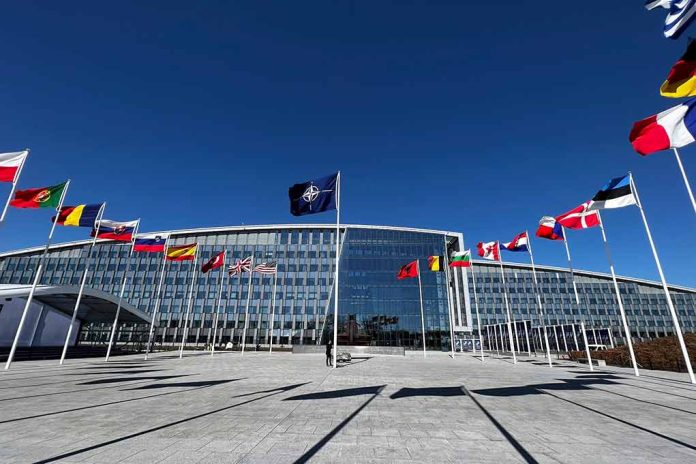
President Trump has threatened to double tariffs on Spanish goods after Spain became the sole NATO nation refusing to commit to a new 5% GDP defense spending target, setting the stage for heightened trade tensions.
Key Takeaways
- Trump warned Spain will “pay twice as much” in future trade deals after rejecting NATO’s new 5% of GDP defense spending target
- NATO leaders agreed to a landmark commitment of investing 5% of GDP on defense requirements by 2035, with Spain being the only member to explicitly reject the target
- The U.S. President intends to bypass standard EU trade protocols to negotiate directly with Spain, setting a July 9 deadline before imposing 50% tariffs
- Other NATO members, particularly those bordering Russia, have condemned Spain’s decision as setting a dangerous precedent
- Trump’s stance represents a significant shift in U.S.-Spain relations and demonstrates his continued commitment to increasing NATO allies’ defense contributions
Trump’s Ultimatum to Spain
In a decisive move that underscores his commitment to NATO burden-sharing, President Trump delivered an unambiguous message to Spain at the recent NATO summit. As the alliance agreed to a groundbreaking new defense spending target of 5% of GDP by 2035, Spain stood alone in outright rejection of the commitment. Trump’s response was immediate and stern, threatening to double tariffs on Spanish imports during upcoming trade negotiations if the country maintains its current position on defense spending.
“I’m going to be negotiating with Spain. I’d rather do it myself than go through the European Union because it’s too complicated. Spain will be paying much more in our deal than they would have paid otherwise,” Trump declared. This direct approach signals a major shift in how the administration plans to conduct trade negotiations with European partners, particularly those failing to meet defense obligations.
President Donald Trump criticizes Spain for not agreeing to new defense spending thresholds adopted by NATO and suggests the country could face tariffs twice as high from the US https://t.co/cTkQyXyDrf pic.twitter.com/knNTVrVxPf
— Bloomberg TV (@BloombergTV) June 25, 2025
NATO’s Historic Defense Spending Agreement
The NATO summit produced what Secretary-General Mark Rutte described as a “transformational” agreement, with member nations committing to substantial increases in defense spending. The new benchmark of 5% of GDP for core defense requirements by 2035 represents a significant escalation from previous targets. Countries bordering Russia, including Poland, the Baltic states, and Nordic nations, along with major European powers such as Britain, France, Germany, and the Netherlands, have all committed to this ambitious goal.
“Allies commit to invest 5% of GDP annually on core defense requirements as well as defense- and security-related spending by 2035 to ensure our individual and collective obligations,” NATO leaders stated in their joint declaration.
The agreement also includes a secondary target of 1.5% GDP for broader defense-related spending, such as infrastructure improvements and cyber defense. This comprehensive approach reflects NATO’s evolving strategy to counter the persistent threat posed by Russia, a point that has gained greater consensus among allies since the invasion of Ukraine.
Spain’s Refusal and Allied Reactions
Spain’s decision to reject the 5% target has drawn sharp criticism from other NATO members, particularly those in Eastern Europe who face more immediate threats from Russia. Spanish officials cited potential strain on the country’s welfare state as justification for their position, a rationale that has not resonated with allies who see defense spending as a fundamental obligation of NATO membership.
Poland’s Deputy Prime Minister was among the most vocal critics, arguing that Spain’s stance undermines alliance unity at a critical moment. The decision appears particularly problematic given the context of Russia’s ongoing aggression in Ukraine and broader threats to European security. President Trump’s administration has set a July 9 deadline for the EU to agree to a trade deal, with tariffs on EU imports to the U.S. set to increase to 50% if no agreement is reached.
Implications for U.S.-European Relations
Trump’s approach to the Spain situation reflects his broader philosophy on international relations and alliance management. By threatening specific trade consequences for defense spending shortfalls, the President is creating direct economic incentives for allies to meet their security obligations. This represents a continuation of his longstanding position that American economic leverage should be used to ensure more equitable burden-sharing within NATO.
“Something that no one really thought possible. And they said, ‘You did it, sir. You did it.’ Well, I don’t know if I did it, but I think I did,” Trump remarked regarding the new NATO agreement, highlighting his role in securing the unprecedented commitment.
The President’s declared intention to bypass traditional EU trade protocols by negotiating directly with Spain signals a potential restructuring of how the U.S. approaches trade relations with European partners. This more bilateral approach could create both challenges and opportunities for trans-Atlantic economic relations, with implications extending far beyond just Spain. Ultimately, Trump’s firm stance demonstrates his commitment to ensuring that all NATO members contribute proportionally to collective security.









